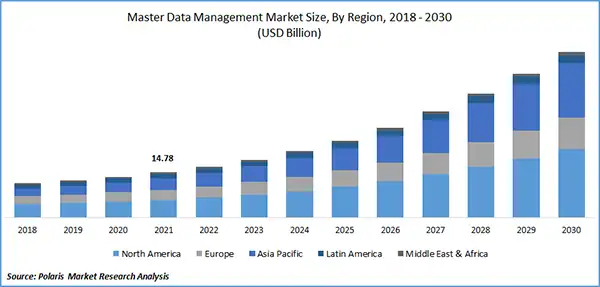Key Takeaways
- Data governance is a framework that helps create, develop, and maintain trust and confidence in the data collected and maintained.
- It is focused on maintenance and accountability. Data Quality Management (DQM) involves the development of data standards to ensure that everything is of the highest quality and consistent across the enterprise.
- Three things are needed for a complete master data management strategy: governance and rules, data quality management, and integration. These parts make sure the data is accurate.
Are you looking for the right MDM option for your company? Read here to find out the three elements of an effective master data management strategy.
What if you could learn what sets the best businesses apart from the competition? What if you knew all of the best practices, hacks, and strategies to become and remain number one in your industry? Well now you can, at least as far as master data management strategy goes.
The growth in master data management across the globe and its related market size is suspected to grow widely in the coming years as shown in the graph below.

That’s right everyone. In this article, we’ll tell you what every business needs to know about MDM and why it’s imperative for success going forward.
To learn more, keep reading.
Data governance is a framework that helps create, develop, and maintain trust and confidence in the information collected and maintained. It is focused on maintenance and accountability.
Data governance sets up the rules, procedures, and roles for controlling and keeping master data up to date. It includes figuring out who owns the data, who has roles and responsibilities with it, and what the quality standards and guidelines are for it.
Data governance is the process of making sure that data is correct, uniform, and up-to-date. It also takes care of data protection, privacy, and compliance issues. These help reduce the risks that come with wrong or poorly handled data. Indeed, the current cloud-native platforms are currently expanding their MDM benefits delivering the best customer data.
Data Quality Management (DQM) involves the development of data standards to ensure that everything is of the highest quality and consistent across the enterprise. Data quality management is all about making master data better. It includes finding errors, duplicates, and wrong or inconsistent data and fixing them.
Data quality managers must know the difference between PIM and MDM. Master data management quality tools and MDM software are used to clean and standardize data. They make sure it meets quality standards that have already been set. MDM has been evolving for the digital economy and molding as per current organizational needs.
Maintaining good data quality makes it easier to make decisions, cuts down on operational inefficiencies, and stops problems caused by bad data from happening later. To maintain the innovation.
Do You Know: The MDM industry believes it will double in the next five years. It will likely grow from $11.3 Billion in 2020 to $27.9 Billion by 2025.
Data integration is the process of bringing together and syncing raw data from different sources into a single, unified view. Harmonization is the process of putting data from different sources into a standard style by mapping and transforming it.
This ensures that data from different systems can be combined and shared across the company in an accurate way. Data integration and harmonization make it easier for people from different departments to work together, cut down on duplication, and give a more complete picture of business information.
In the current digital world scenario as shared by the report of Accenture, “traditional MDM is focused on establishing a sanitized single version of the truth… While this is still vital, its value alone has diminished in the digital era.” Instead, currently, some of the major enterprise changes are brought by efforts of MDM to meet the demands of the customers.
Remember These Elements When Creating a Master Data Management Strategy
Three things are needed for a complete master data management strategy: governance and rules, data quality management, and data integration. These parts make sure the data is accurate and provide a single form of truth from which insights can be drawn.
Companies that take the time to invest in a good MDM strategy will be able to make better choices, improve efficiency, and get a better ROI. Contact your service provider to find out how to create an MDM plan for your business. Interestingly, the current trends in the master data management system in leveraging the best from machine learning and AI.
If you found this helpful and want to read more great content, check out our latest blog posts now!